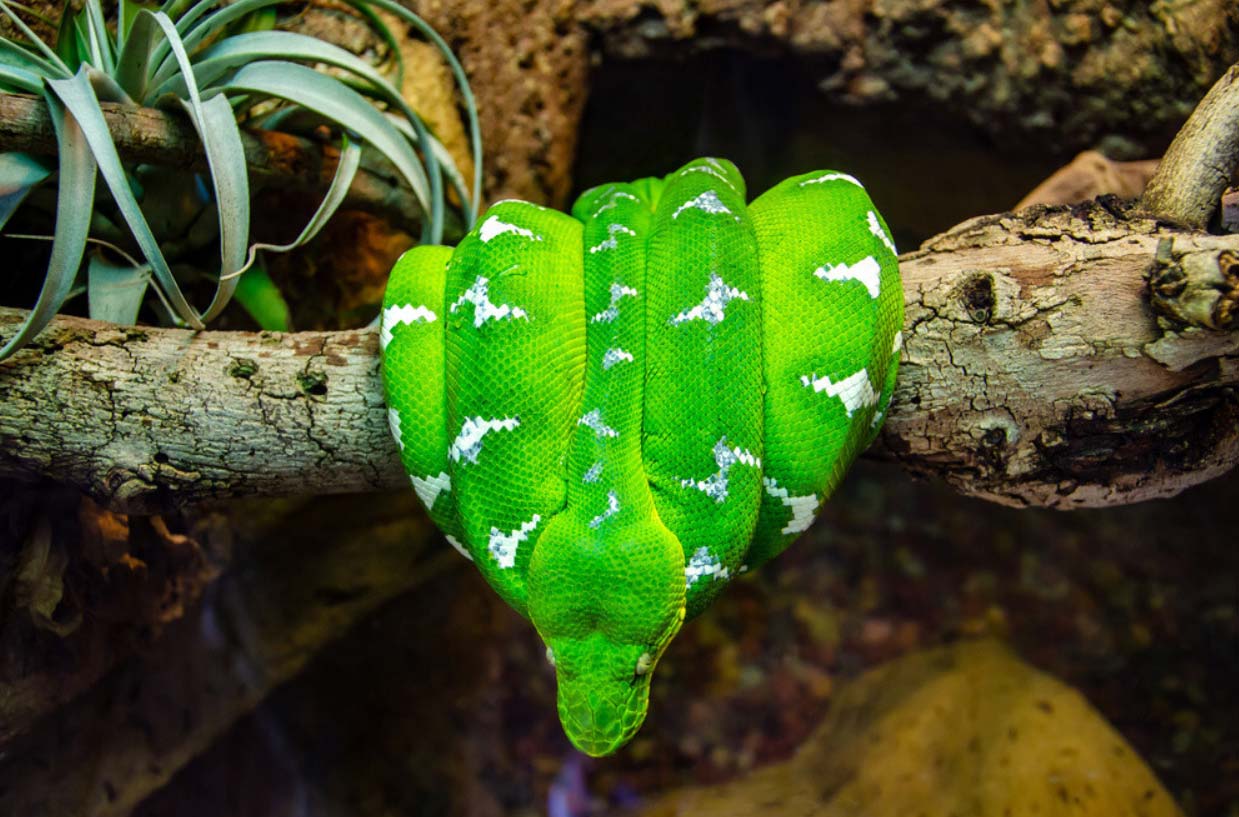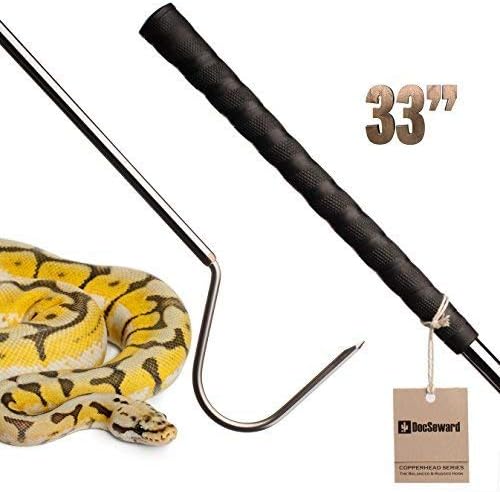A true jewel in any herp-enthusiasts collection.
The Emerald Tree Boa is a stunning pet to have. Due to their coloring and arboreal nature, they are excellent candidates for display enclosures.
They are green with white or yellow markings. They spend most of their time coiled on a perch with their heads nestled in the middle of their coils or hanging down.
These are not the snakes for frequent handling. Handling them and passing them around can cause unnecessary stress and their prehensile tails can be easily damaged.
If you are looking for an enchanting display snake this is the one for you.
| Common Name: | Emerald Tree Boa, Emerald boa, Green Tree Boa |
| Scientific Name: | Corallus caninus |
| Natural Habitat: | South American Tropical Rain Forest (Canopy) |
| Adult Size: | Four to six feet |
| Lifespan: | 15 years |
| Diet: | Small arboreal animals |
| Experience Level: | Intermediate to Advanced |
| Enclosure Size: | 3 feet long X 2.5 feet wide X 2.5 feet high |
Reptile Overview
These snakes were originally named by Carlos Linnaeus in 1758. He named them Corallus for the coral color of the juveniles and caninus for their dog-shaped head and long canines.
There are two variations of the Emerald Tree Boa owing to their geolocations.
The northern boas, generally found in Brazil, are protected by CITES and the Brazilian government.
- This means that wild or captive boas may not be exported from Brazil.
- Unfortunately, some still make it out in the illegal pet trade; these boas tend to be more aggressive than their southern counterparts.
The southern boas are generally found in the Amazon basin and are sometimes misleading called Amazon Tree Boas.
- These boas are more commonly found in the pet trade and have a calmer temperament than the northern snakes.
Please Note: At the time of the creation of this care guide, the two variations have not been separated into separate subspecies. However, there is a lot of discussion surrounding the issue.
Emerald Tree Boas are listed as least concern by CITES. However, the poaching of wild snakes for the pet trade may impact their future numbers if not properly curbed.
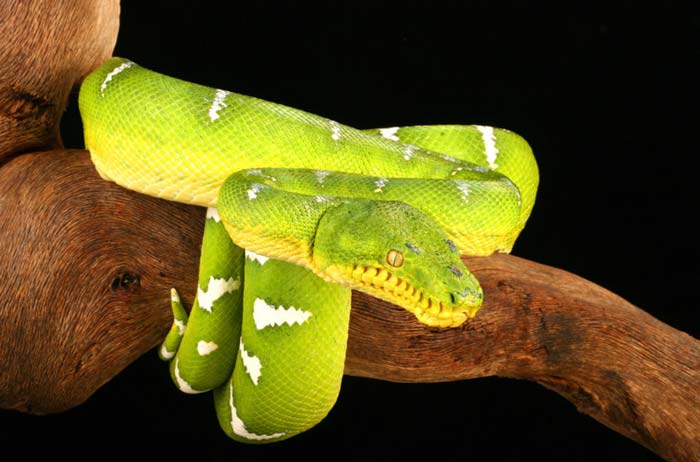
We always suggest getting your snakes from a reputable local breeder instead of international trade.
Wild-caught snakes can come to you malnourished, sick with parasites, overly stressed, and more aggressive. Buying wild-caught snakes also encourages poaching and illegal pet trading.
Temperament
As previously mentioned, there are two variations of the Emerald Tree Boa. The northern from Brazil and surrounds and the southern from the Amazon basin and surrounds.
- The northern Emerald Boa is generally more aggressive and does not respond well to handling.
- The southern Emerald Boa has a more docile temperament and is more suited to the life of a pet. However, incorrect handling will promote a defensive response.
Behavior
These snakes are arboreal, meaning they live in the tree canopy in the tropical rainforest. They are so well suited to the tree life that they almost never come down to the ground.
You will see your snake almost always perched on a branch in their enclosure in the typical U-shape of tree-dwelling boas.
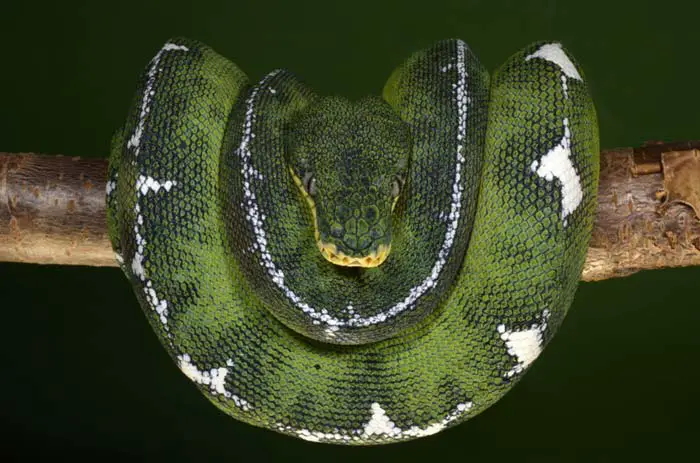
Emerald Boas are typically nocturnal creatures. This means they are most active at night.
They will hang their heads down in an S-shape, typically at night, while waiting to ambush prey on lower branches, this is why having a tall cage is important.
Lifespan
The average Emerald Tree Boa lives to 15 years. Owning one is a long-term commitment, so make sure you are up for it.
Appearance
Size
These snakes can reach an impressive four to six feet in length. The southern variation from the Amazon basin has been reported to reach nine feet in length.
They are wiry looking with slender bodies. This often leads to overfeeding by new owners.
These snakes are thinner than would be expected because they cannot be too heavy for the branches in the upper canopy to hold them.
Typical of most snake species, the male is slightly smaller than the female. However, he has larger anal spurs on either side of the cloaca that he uses during mating to grip the female.
Shape
The head of the Emerald Boa is heart-shaped and dog-like looking. It attaches at the base of the skull to a much thinner neck.
The body tapers down to a tale that is prehensile. This means that the tale acts as an anchor and grips tree branches.
Coloring
Neonates and juveniles are usually reddish or orange in color. If your juvenile is yellow then you probably have got yourself a Green Tree Python, not an Emerald Tree Boa.
The northern and southern variations have a green background color. This can be dark emerald green to a brilliant middle green.
The southern variation usually has a white dorsal stripe that is unbroken with other white or yellow marking down the sides of the body.
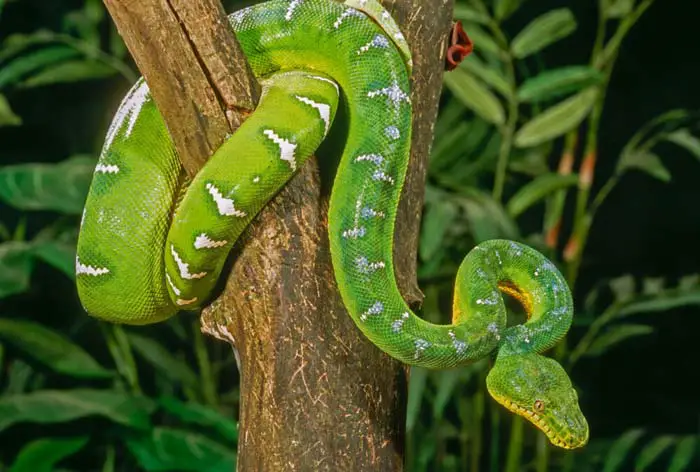
The northern variation will have unique and unpredictable yellow or white markings down the body, often described as “lightening” markings.
Occasionally these markings can be completely absent, or they can be black, or they can be mixed white, black, and yellow. The belly of both variations is usually a pale yellow to white color.
Enclosure
Size and type
These snakes are evolved for an arboreal habitat. Therefore, their enclosure must mimic their natural tree-top habitat as far as possible.
Neonates and juveniles can be housed in a 10 to 20-gallon Rubbermaid-type container.
Adults need room to move horizontally through the temperature gradient and climb vertically to feel comfortable. We recommend an enclosure that is 3 feet long by 2.5 feet wide by 2.5 feet high.
REPTI ZOO Large Glass Reptile Terrarium
The enclosure can be any material that is able to contain humidity and heat well. We recommend that the enclosure’s sides, back, and top are not transparent as this can stress the snake.
A front opening enclosure is ideal for cleaning and handling purposes. Make sure that the door latches securely as these snakes like to explore their options.
Make sure the enclosure is well ventilated but in a way that does not affect the humidity levels. A small computer fan mounted on the top screen of the enclosure is a great way to achieve this.
Set up
Your snake is going to spend 95% of its life in that enclosure. Make it as interesting and enriching as possible.
Emerald Tree Boas are arboreal snakes, therefore focus your attention on making that aspect of the enclosure the best.
Put perches that run horizontally at different levels in the enclosure. Your snake should be able to reach any of these perches at all times because they will all be at different temperatures.
Add some perches that run vertically so your snake can climb using different muscles. All perches MUST be secured so that no harm comes to your snake.

The perches can be anything safe for the snake. They can be PVC piping, natural branches, wooden dowels, etc. as long as they are thick and strong enough to hold your snake securely.
If you use wood, the best way to keep them sanitary and safe for your snake is to boil them in water and let them dry completely. You will need to keep a careful eye on them for mold and fungus as the humidity levels are high.
We suggest you have a perch that is removable so that you can take your snake out of the enclosure when you clean or when you want to handle it.
Hang real or fake vegetation in the enclosure to create a natural feel and to provide your snake with some privacy. We recommend silk plants as they are easy to keep clean.
Substrate
There are two routes you can go when it comes to the substrate: natural or practical.
The natural route involves having real vegetation and soil in the enclosure with a natural drainage system. This route is difficult to maintain and requires a lot of time and effort on the part of the owner.
- The reward for such an enclosure is huge. Your display enclosure will be a magnificent example of the Emerald Tree Boa’s natural habitat and your devotion to your snake.
- However, if you do not know how to maintain a natural enclosure, you can cause serious harm to your snake. So do your homework before attempting it.
The practical path is exactly that: practical. It also happens to be easier to clean, easier to monitor, as well as cheaper.
- Substrate can include newspaper that is changed daily or wood chips that are agitated daily and changed weekly. Even if there is no fecal matter, you must change the newspaper or paper towel daily to avoid mold.
- Pick your wood chips/natural substrate carefully; never use cedar or pine as they have oils in them that are toxic to your snake. Aspen, orchid, coconut fiber/husks, and cypress mulch are all good choices.
Temperature
The enclosure needs to be long enough to maintain a stable temperature gradient.
We suggest you put a thermometer on the coolest side of the enclosure, the warmest, and in the basking spot to accurately maintain the gradient.
Our recommendation is to use Zoo Med Labs Digital Hygrometer & Thermometer.
Zoo Med Labs Digital Hygrometer & Thermometer
As this snake is arboreal an under-tank heating pad is not suitable. We suggest a heating panel that is secured to one side and that overlaps a third of the top of the enclosure.
Our recommendation is to use VIVOSUN Reptile Heating Pad with Digital Thermostat.
VIVOSUN Reptile Heating Pad with Digital Thermostat
Cool Side
This side of the enclosure should be around 80°F day and night. Make sure you have vegetation/decoration that provides enough coverage to completely shield the snake in one spot here.
Warm Side
This side of the enclosure should be around 85°F day and night. Make sure you have vegetation/decoration that provides enough coverage to completely shield the snake in one spot here.
Basking Area
The basking area should be no higher than 88°F. You can achieve this with a heating light or a ceramic heat bulb. Both must be in a protective dome so the snake does not burn itself.
Lighting
Emerald Tree Boas are nocturnal and need a 12/12 light and dark cycle to function properly. This is why we recommend a heat source that is separate from the heating bulb.
Your snake does not require special UVB lighting. However, it does have added health benefits, like improved immunity, and brings out different hues in your snake’s scales.
You can use a combination UVB and heat bulb like Mega-Ray Mercury Vapor Bulb or you can use LED lighting that does not affect the temperature gradient. For this purpose we are using Zoo Med Reptisun Led Terrarium Hood.
Zoo Med Reptisun LED Terrarium Hood
ALWAYS put your lighting and heat sources in a protective dome to prevent damage to your snake.
Humidity
Emerald Tree Boas come from the tropical rainforest and require high humidity: 70% to 80%.
To create and maintain this level of humidity, we recommend to use humidifier/fogger like REPTI ZOO Reptile Mister or mist the enclosure’s substrate every morning. Do not mist the snake directly.
Take some saturated newspaper or paper towel and place it in the warmer corner of the enclosure. As the water evaporates it will add constant humidity to the enclosure.
A great way to maintain humidity is to have a real plant in the enclosure or one of the branches covered in sphagnum moss.
Galápagos Terrarium Sphagnum Moss
If you have real wood in the enclosure, or the enclosure is made of wood you need to keep a careful eye out for mold and other fungal growth. This will make your snake, and you sick.
If your snake is having trouble shedding, increase the amount of water you spray into the enclosure. This will increase the humidity and ease the shedding process.
We recommend a quality hygrometer is installed in the enclosure to accurately monitor humidity levels.
Diet
Your Emerald Tree Boa must have access to ample fresh water every day. The water bowl should be large enough for the snake to fit in it but not to overflow it.
If the water dish overflows it can raise the humidity levels and cause health issues for your snake.
The water should be replaced every day. You would not drink old, dirty water, your snake should not either.
We never recommend live prey. Feeding live prey to your snakes comes with risks:
- Parasites and diseases
- The prey item can harm the snake
Live prey needs to be housed properly as well so you need to consider all of these things.
We recommend thawed frozen prey. These prey items cannot infect your snake with parasites or diseases provided they have been stored correctly.
- Neonates should be started on one thawed pinky mouse a week. As your snake gets larger, so should their prey item.
- Our feeding formula: Prey size = girth of the largest part of the snake (not the head)
- At two years old their schedule can be altered to one prey item of the correct size every two weeks.
To feed your snake, take its prey item and put it in a bowl of hot water to thaw. When it has completely thawed and is at room temperature, offer it to your snake.
DO NOT feed your snake partially frozen prey as the temperature difference is fatal.
We recommend you feed your snake at dusk or just before the lights go out in their enclosure as they are nocturnal animals.
Defecating
If your snake has gone more than five meals without defecating, take it to a “rainfall” chamber. This is a chamber that simulates rainfall and will encourage your snake to defecate.
You could do this in a manufactured rainfall chamber, build one yourself, or secure a branch in your shower. Just don’t jump in with it, things might get a little dicey.
If you use a rainfall chamber, you must monitor the water temperature carefully and ensure the water is clean and fresh as the snake will drink from the water on its scales.
Handling
As we have said before, the two variations of the Emerald Tree Boa have different temperaments. Whether you have a northern or southern Emerald Boa, you should not handle it more than absolutely necessary.
The snake’s tail is prehensile and incredibly delicate, especially in neonates and juveniles. If you yank the snake off its perch or hold it incorrectly, you can permanently damage its tail which means it will not be able to anchor itself on a perch.
Remove your snake from its enclosure on a removable perch or with a snake hook. Emeralds Boas have large teeth and will strike out defensively.
We recommend only handling your snake in the middle of the day when it is the least active and less likely to strike.
NEVER handle your snake 24 hours before, during, and for 48 hours after feeding. You will get bitten or your snake will regurgitate its food due to stress.
Potential Health Issues
Parasites
- As with most snakes, mites are a common problem for Emerald Tree Boas. Mites are small parasites that burrow under the snake’s scales.
- You can spot them on your snake or their substrate as tiny red or black dots. If your snake is over-soaking, it might be a sign of mites.
- Mite infestations need to be dealt with immediately as they carry their own parasite that can further harm your snake.
Mite infestations usually develop because of improper enclosure care. As soon as you spot them, sanitize the enclosure.
Humidity
- Most snakes suffer from respiratory issues if the humidity levels are too high. Your Emerald Boa is no different.
- If your snake starts bubbling or gurgling then reduce the humidity in the enclosure and get an exotic vet involved.
- If the humidity is too low, your snake will struggle to shed. If shedding is a problem increase the humidity levels.
Bacteria
- If there is improper enclosure care, namely too high humidity and infrequent cleaning then your snake can develop a bacterial infection called scale and mouth rot.
- Check your humidity levels, sanitize the enclosure, and get an exotic vet involved.
Obesity
- Obesity is a problem in captive Emerald Tree Boas because the snakes will rarely turn down food regardless if they are hungry or not.
- A fat snake is not a funny snake. Obesity puts a strain on the heart and liver and is fatal if not treated.
- Maintain a proper feeding schedule to maintain a healthy snake.
Breeding
Males reach sexual maturity at three years old and females at four. Do not breed females that are under four feet in length.
A brumation period is not necessarily required with Emerald Tree Boas as they are tropical snakes. However, it can encourage successful mating:
- At the beginning of winter reduce the overall temperature of the enclosure by 5°F. Do not let the temperature drop below 75°F.
- Increase misting and raise the humidity levels to 90%. Conditions like these tell the snake breeding season is approaching.
Introduce the male to the female’s enclosure instead of the other way around. You can leave him in the enclosure for a month or a week at a time if he is being cycled between different females.
Maintain normal feeding schedules during this time but remove the male to eat in his own enclosure to avoid accidental aggressive behavior.

After a month, remove the male, the female should be gravid and show this with a slight bulge in her belly that will grow over time. Return her enclosure settings to normal.
The female will be pregnant for roughly 250 days. She may go off food the closer it gets to birthing time.
We say pregnant because Emerald Tree Boas are ovoviviparous snakes which means they keep the eggs inside the body and birth “live” young.
Your female will do a pre-birthing shed. When this happens place a largeish wooden or plastic box in her enclosure that is lined with newspaper, paper towel, or sphagnum moss.
She will lay 6-14 babies and probably a couple of unfertilized eggs. Remove the babies very carefully to their own enclosure.
Resume a normal feeding schedule for the female.
Conclusion
If you are in the market for a stunning display snake look no further than the Emerald Tree Boa. These snakes are magnificent creatures that have striking coloring and interesting behavior.
While they are more difficult to take care of due to their temperaments and enclosure requirements, they are worth every hour spent maintaining them. Intermediate to advanced herp enthusiasts should take great pride in their beautiful Emerald Tree Boa.
We wish you the best and “herp” you enjoy your journey with your new boa friend.
Related:

